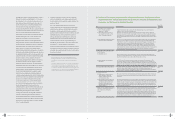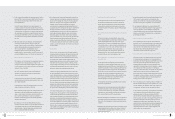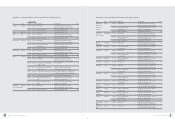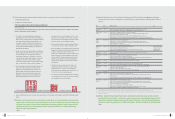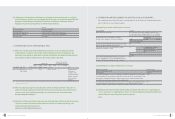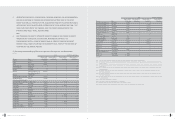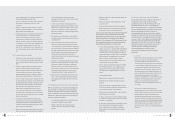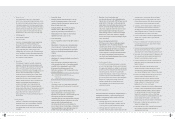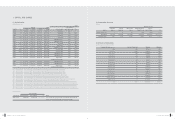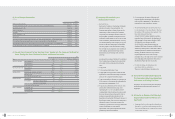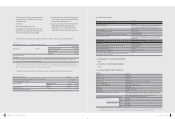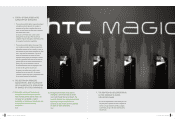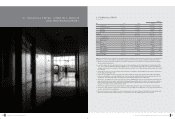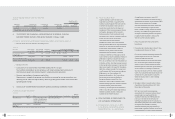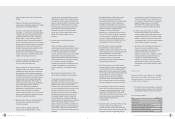HTC 2008 Annual Report Download - page 47
Download and view the complete annual report
Please find page 47 of the 2008 HTC annual report below. You can navigate through the pages in the report by either clicking on the pages listed below, or by using the keyword search tool below to find specific information within the annual report.
89
•
Reduction of circuit board surface area
In keeping with the need for slim, lightweight devices
that also have rich functionality, HTC has begun using an
advanced form of multi-layer circuitboard design that
greatly reduces the circuitboard's required surface area.
In 2008, some newly developed models achieved a
reduction in circuitboard surface from 56cm2to 16cm2,
while retaining the same functionality. This type of
advanced design results in a reduction in both weight
and the use of circuit boards, furthermore, helping to
save resources as well as reduce the subsequent burden
on the environment.
•
One-piece packaging design methods
HTC makes use of a one-piece cardboard packaging
material made of 100% recycled pulp and that is
recyclable, as shown below, in a clever design developed
by our packaging design experts that use packaging
material to maximum efficiency to reduce its overall
volume. The product is well protected even without the
use of plastic foam packaging, which brings further
reductions in unnecessary packaging in order to achieve
our goals for green packaging.
6. Looking toward the future
In 2008, HTC successfully made environmental concepts such
as lower toxicity, higher energy efficiency, and recyclability part
of its green product design efforts, resulting in the development
of numerous "green" products with highly creative designs and
environmental concepts. HTC's spirit of constant forward
progress in these areas will continue in the future. HTC has set
out even more rigorous environmental standards as design
goals for new products in 2009, and its continued development
and promotion of green products will help it to meet the
standards of international environmental laws as well as
customer demands as it moves ahead toward the vision of
sustainable development.
(5) HTC Foundation
In 2008, HTC and HTC Social Welfare & Charity Foundation or
HTC Education Foundation, to which it donates each year,
engaged in community participation through the following
public interest activities:
1. Continuing support for 200 children from low-income
households in Haiti and the Republic of Ghana for the fourth
consecutive year in cooperation with World Vision Taiwan.
2. Continuing support for 89 children from low-income
households in the Yuli Township of Hualien, Taiwan, for the fifth
consecutive year in cooperation with World Vision Taiwan.
3. Sponsorship of after-school study-program for 300 children
from low-income households, for the fifth consecutive year in
cooperation with the Chinese Christian Relief Association.
4. Contributions by the Foundation and HTC of NT$20 million
each to disaster relief in Sichuan Province for donation to
rebuilding projects in disaster regions. Employees have also
donated nearly NT$ 4 million for construction of the Chadian
Township elementary school in Mian County, Shanxi.
5. Provision of NT$ 3 million for assistance to Myanmar hurricane
disaster relief in cooperation with the Ling Jiou Mountain
Buddhist Foundation.
6. Provision of scholarships for 1,000 students for the second
consecutive year at six schools in China's remote northwest
regions and Qinghai Province.
7. Provision of tuition and board year-round for 100 needy senior
high school students for the second consecutive year with
outstanding records in China's Ningxia and Liaoning Provinces.
8. Sponsorship of Good Deed Representative Yin Guanghua for the
third consecutive year in giving character-building lectures at
hundreds of schools and prisons around the country.
9. Provision of assistance for the second consecutive year to the
Rehabilitation Hope Project at the Development Center for the
Spinal Cord Injured.
10. In addition, HTC provides long-term support for youth
education and character-building organizations for the fifth
consecutive year, including the Champions Education
Association and the Rainbow Family Life Education Association.
11. Provision of free Carnegie motivation training course to school
teachers through the "Pan Shi Education Project" for a
cumulative total of 20,000 persons and teacher character
education training for a cumulative total of 15,000 persons
throughout Taiwan. In 2008 we promoted the "Character
Building Schools" for 16 schools in Taoyuan.
12. Contribution to establishment of a Character & English Institute
in Hualien County by providing full sponsorship for attendance
for all 4th-grade elementary students in Hualien County at a
five-day four-night camp for character building and English
learning. HTC contributes tens of millions of New Taiwan
Dollars in sponsorship for all operating and upkeep costs, while
also participating in development of courses that provide
English teaching to minorities and residents of remote districts.
13. Sponsorship of children from low income families, in the
Taoyuan County English Village.
14. Continuing promotion of HTC's "Character Township" plans for
public servants in 5 townships, providing training to a
cumulative total of 2,000 visits.
IV. CO RPO RATE GOVERN AN CE
88
2. Energy efficiency
In the overall life cycle of an electronic communications
product, the most energy-intensive stage is the period of use by
the consumer, and energy use during this stage is a major cause
of greenhouse gas production. For that reason we give intense
scrutiny to the question of energy efficiency during the research
and development phase, and all power supplies used with HTC
products must conform to the international energy efficiency
standards below in order to reach our goals for saving energy.
> US EPA Energy Star
> California Energy Commission
> EU Code of Conduct
In addition to formulating standards for power supply energy
use, our R& D team has developed outstanding power
management systems that respond to consumers' habitual
modes of use and allow the handset to automatically enter an
energy-saving standby mode, reducing energy use and
extending battery life. Some models also include ambient light
sensors that trigger an automatic LCD backlighting adjustment
function, which in addition to creating more readable displays,
also contributes to energy saving goals.
3. Recyclability
The primary goal of design-for-recyclability is meeting the
requirements of international environmental regulations with
regard to recycling rates. HTC's standards for product recycling
rates in 2008 used assessment criteria taken from the EU's
Waste Electrical and Electronic Equipment (WEEE) Directive. For
the above reasons, HTC makes design-for-recyclability
assessments and other simulations part of its initial research
and development phase. Product disassembly and materials
simulations are carried out to allow calculation of product
materials compositions and their relative recycling rates, while
strategies involving materials labeling, simplification of
assemblies, and design for ease of disassembly provide
feedback to R&D units in the form of design strategies with
reference value for R&D processes. These procedures mean that
recycling operations can be carried out smoothly during the
disposal phase at the end of a product's useful life cycle,
enhancing the benefits of recycling and reducing the impact on
the environment.
4. Green packaging
In addition to considerations of visual appeal and packaging
strength requirements, HTC's green packaging concepts also
extend to the development of materials that satisfy the
environmental design concepts of low toxicity, low volume, and
recyclability:
> Low-toxicity design
•
Packaging materials meet the standards of the EU
directive on packaging materials. Levels of lead,
cadmium, mercury, and hexavalent chromium are all
below the limits fixed by law.
•
Packaging materials use no PVCs. Packaging
materials contain no ODS (ozone depleting
substances) restricted by the Montreal Protocol.
•
Printing inks are low-volatility or environmental
vegetable-based inks such as soy ink.
> Low-volume design
•
No use of expanded polystyrene foam (EPS) beads for
packing
•
Maximization of stacking volume during shipping to
reduce the amounts of packing materials required
•
Improved shock-absorbing packaging, reducing the
need for shock-absorbing packing materials during
shipping
> Design-for-recycling
•
Manufacture of corrugated board with more than 90%
recycled pulp
•
When visual design considerations make the use of
virgin materials unavoidable, all packaging materials
meet FSC
1
(Forest Stewardship Council), PEFC
2
(Programme for the Endorsement of Forest
Certification schemes), or SFI
3
(Sustainable Forestry
Initiative) certification.
1
FSC Forest Stewardship Council
;
http:www.fsc.org
2
PEFC Programme for the Endorsement of Forest Certification
;
http:www.pefc.org
3
SFI Sustainable Forest Initiative
;
http://www.sfiprogram.org/
5. Eco-design cases
HTC employs a variety of eco-design strategies during R&D
stages, resulting each year in the development of a wide variety
of green products:
•
Environmental surface treatment methods While a
lustrous metallic finish is a necessary part of the
appearance of HTC products, it cannot interfere with their
radio frequency functions and electromagnetic
compatibility. HTC thus uses the NCVM (non-conductive
vacuum metallization) surface treatment process, which
meets the needs of both visual design and
telecommunications functions, and in addition, the
process reduces the use of nickel plating, contributing to
clean manufacturing processes and helping reduce the
problem of some users' skin allergy to nickel.
2OO 8 HTC AN N UAL REPO RT
'0 8A R_ HT C/ 英文版* NEW 05/ 21/ 20 09 11: 02 頁面 8 8


